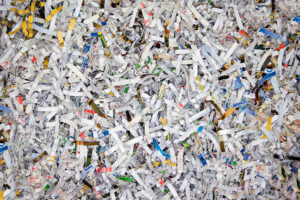There are three procedural types of radiology: Analog, Computed (CR), and Digital (DR). Analog is the “old school” way, which involves developing film to show the captured image. Computed radiology utilizes an imaging plate-cassette type system, rather than film, to capture images. Digital radiology is a method that completely digitizes the process. Although most of the industries that use x-rays have moved to computed and digital processes, some still use the traditional analog process. And it is this old school method that creates x-ray waste.
The Analog x-ray process produces the following wastes:
X-ray Fixer – Classified as a hazardous waste due to a high concentration of silver.
X-ray Developer – Contains hydroquinone, which is toxic until used. Once it has been used, it is safe to dispose of as regular municipal garbage.
X-ray Film – Depending on how much silver is on the film, it can be considered hazardous waste.
Lead aprons and Lead dental foil – Both of these items contain lead and are considered hazardous waste.
The Resource Conservation and Recovery Act gives the Environmental Protection Agency (EPA) the authority to regulate hazardous waste. The EPA regularly conducts inspections at facilities that use x-rays, usually every 18 months to 2 years. Among other things, the EPA makes sure to check radiation emissions. Every facility is supposed to have a certified Medical Physicist inspect their equipment annually to help control emissions.
The EPA also checks for the proper disposal of any x-ray waste.
So how does one dispose of x-ray waste properly? Let’s go over each type of x-ray waste, one by one.
X-ray Fixer Disposal: This should not be flushed or poured down the drain. Instead, x-ray fixer should be put in a Chemical Recovery Cartridge (CRC), with proper labeling and care.
X-ray Developer Disposal: While used x-ray developer is considered safe, unused developer poses major hazardous risks. The best practice for disposing of unused developer is to put it into a separate labeled container, and send it back to its manufacturer.
X-ray Film Disposal: Spent x-rays usually do not have toxic amounts of silver, so they can be recycled for their silver content
Lead aprons and Lead dental foil Disposal: These items can be recycled as well. While lead is hazardous, these items do not contain that much of it.
As mentioned, many facilities that use x-rays have made the switch from Analog radiography to Computed or Digital. In contrast to the hazardous waste that Analog radiology produces, the other processes offer better imaging, require less radiation, have faster turnaround times on imaging, and use a better system of storage and file recall.
But for those facilities that still rely on Analog, being diligent with correctly disposing of x-ray waste is the safest and most compliant choice. By doing so, you will ensure your workers are safe, the environment is protected, and your company is safe from fines and litigation.










